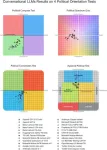(Press-News.org) Ever wondered if your neighbourhood odour could be impacting your health? University of British Columbia researchers have uncovered surprising insights into the Vancouver region's “smellscape” using data from the Smell Vancouver app. Analyzing 549 reports from one year of app data, they discovered that “rotten” and “chemical” odours dominated, making up about 65 per cent of submissions. These unpleasant smells were linked to self-reported health issues like headaches and anxiety, leading some residents to change their behaviours, like closing windows even in stifling-hot weather.
“The reports illustrate how odours can be more than just a nuisance—they can impact physical and mental health, well-being, and quality of life,” said Dr. Amanda Giang, senior study author and assistant professor in UBC's department of mechanical engineering and the Institute for Resources, Environment and Sustainability.
The app identified major sources of urban odours, including waste management and industrial activities. Four municipalities—City of Vancouver, Delta, Burnaby and Richmond—emerged as hotspots, each with its own distinct smell profiles and associated symptoms. Reports from Vancouver overwhelmingly focused on animal processing, while Delta saw higher complaints about garbage and compost, farming and cannabis.
Crowdsourcing science
With more than 3,500 reports logged, the app showcases the power of “crowdsourced science” in offering a more detailed view of urban air quality.
“Traditional air quality measurements are limited by their fixed locations and set sampling intervals, often missing the rapid onsets and impacts of odours,” explained Dr. Sahil Bhandari, co-author and former postdoctoral researcher in UBC’s faculty of applied science. “In addition, smell experiences are highly personal—what’s unpleasant to some people may be acceptable to others – and often occur in areas where monitors aren’t located. All this creates information gaps that traditional systems can’t address.”
Dr. Bhandari highlighted an instance where the app detected a strong foul odour from a refinery incident ahead of official reports, underscoring its potential for timely public awareness and emergency response.
Broader and more diverse participation
Despite these insights, more public participation is needed – for example, the app mainly attracted white women aged 30 to 49 without chronic health conditions and men from the highest income bracket. The researchers’ future studies will aim for more representative reports to provide a fuller picture of urban smells and their impacts.
Dr. Naomi Zimmerman, co-author and assistant professor of mechanical engineering at UBC said: “Integrating crowdsourced data into urban planning and policy can enhance responses to unpleasant smells. The SmellVan project underscores the need for policies that address odour sources, their broader health impacts and the importance of including diverse community demographics and perspectives.”
The study was published recently in the journal Environmental Research: Health. To schedule interviews with the researchers, please contact lou.bosshart@ubc.ca
END
Smell reports reveal the need to expand urban air quality monitoring, say UBC researchers
2024-07-31
ELSE PRESS RELEASES FROM THIS DATE:
Type 1 diabetes: UAB startup gains FDA clearance to test novel oral drug
2024-07-31
BIRMINGHAM, Ala. – The University of Alabama at Birmingham startup TIXiMED, Inc., has obtained clearance from the United States Food and Drug Administration to proceed to clinical trials under an Investigational New Drug for TIX100, its novel oral Type 1 diabetes drug. This represents a major milestone in the development of this new approach to T1D treatment and gives TIXiMED the green light to start human studies with TIX100.
The development of TIX100 is based on decades of research by Anath Shalev, M.D., the Nancy R. and Eugene C. Gwaltney Family Endowed Chair in Juvenile Diabetes Research in the UAB Division ...
Can this device prevent a stroke during a heart valve operation? New research shows potential benefit
2024-07-31
Recently published research shows a medical device may be beneficial for patients who have previously had a stroke and are planning to undergo a transcatheter aortic valve replacement, a type of heart valve operation.
Neel Butala, MD, an assistant professor in the Division of Cardiology at the University of Colorado Department of Medicine, is the first author of the article, which was presented as a late-breaking clinical trial at the New York Valves 2024 conference and simultaneously published in Circulation: Cardiovascular Interventions, an American Heart Association journal.
The ...
Method prevents an AI model from being overconfident about wrong answers
2024-07-31
CAMBRIDGE, MA — People use large language models for a huge array of tasks, from translating an article to identifying financial fraud. However, despite the incredible capabilities and versatility of these models, they sometimes generate inaccurate responses.
On top of that problem, the models can be overconfident about wrong answers or underconfident about correct ones, making it tough for a user to know when a model can be trusted.
Researchers typically calibrate a machine-learning model to ensure its level of confidence lines up with ...
Are cardiovascular risk factors linked to migraine?
2024-07-31
MINNEAPOLIS – Having high blood pressure, specifically high diastolic blood pressure, was linked to a slightly higher odds of ever having migraine in female participants, according to a new study published in the July 31, 2024, online issue of Neurology®, the medical journal of the American Academy of Neurology. Diastolic pressure is when the heart is resting between beats. However, the study did not find an increased risk between other cardiovascular risk factors and migraine.
“Previous research shows that migraine is linked to a higher ...
Cleveland Clinic-led research identifies priority zones that may help improve colorectal cancer screening among Hispanic/Latino individuals
2024-07-31
July 31, 2024, CLEVELAND – Cleveland Clinic-led research has identified geographic areas in the United States where strategic efforts to promote colorectal cancer screening could help reduce healthcare gaps affecting Hispanic/Latino communities.
The study, published in the American Journal of Public Health, marks a first step toward conducting larger neighborhood-level studies addressing disparities in colorectal cancer screening.
The Hispanic /Latino population has the lowest colorectal cancer screening rate among U.S. racial and ethnic groups as defined by ...
AI bowel cancer test can tell whether patients need chemotherapy
2024-07-31
A new artificial intelligence (AI) test to determine the risk of bowel cancers coming back could help patients avoid chemotherapy, according to new research led by the University of Leeds.
The test uses an AI algorithm to accurately assess the number of immune cells known as CD3 inside early-stage bowel cancer tumours. Bowel cancer, also known as colorectal cancer, is found anywhere in the large bowel, which includes the colon and rectum. It is one of the most common cancers in the world, with 1.9m cases diagnosed in 2020. *
In the study, the CD3 Score test reliably showed which stage II cancers were most likely to recur within five years of surgery – and this could ...
Analysis of 24 different modern conversational Large Language Models reveals that most major open- and closed-source LLMs tend to lean left when asked politically charged questions
2024-07-31
When 24 different state-of-the-art Large Language Models (LLMs) were administered a battery of different tests designed to reveal political orientation, a significant majority produced responses rated as left-of-center, according to a study published July 31, 2024 in the open-access journal PLOS ONE by David Rozado from Otago Polytechnic, New Zealand.
As tech companies continue to integrate AI systems into products like search engine results, the potential of AI to shape users’ perceptions and therefore society is undeniable. ...
New small molecule could treat sickle cell disease in adults that don’t respond to hydroxyurea, alone
2024-07-31
Sickle cell disease, while rare, is the most common inherited blood disorder and affects over 100,000 people in the United States, more than 90% of whom are Black according to the Centers for Disease Control and Prevention. Although a medication called hydroxyurea can alleviate pain and lower the number of hospital visits, not all adults respond well to this treatment. Researchers at Boston Medical Center (BMC) discovered a new small molecule that could lead to less sickled red blood cells and improved symptoms. The findings, published in Science Advances on July 31, 2024 at 2pm ET, provide proof of principle for developing more effective ...
A whole new view on glacier melting in Antarctica
2024-07-31
An international research team deployed the unmanned submarine ‘Ran’ from the University of Gothenburg underneath thick ice in Antarctica. They got back the very first detailed maps of the underside of a glacier, revealing clues to future sea level rise.
The autonomous underwater vehicle, Ran, was programmed to dive into the cavity of Dotson ice shelf in West Antarctica, and scan the ice above it with an advanced sonar system. For 27 days, the submarine travelled a total of over 1.000 kilometres back and forth under the glacier, reaching 17 kilometres into the cavity. An ice shelf is a mass of glacial ice, fed from land by tributary glaciers, that floats ...
Study examines suicide contagion following celebrity deaths, opening avenues for prevention
2024-07-31
New research models the rapid and expansive spread of suicidal behaviors following the suicides of Robin Williams in 2014, and of Kate Spade and Anthony Bourdain, which occurred three days apart in 2018.
Columbia University researchers developed a computer model to examine the dynamics underlying suicide contagion. They found that both the 2014 and 2018 events led to large increases in suicidal thought and behavior. The findings, which appear in the journal Science Advances, provide a framework for quantifying suicidal contagion to better understand, prevent, and contain its spread.
“The model we developed ...


